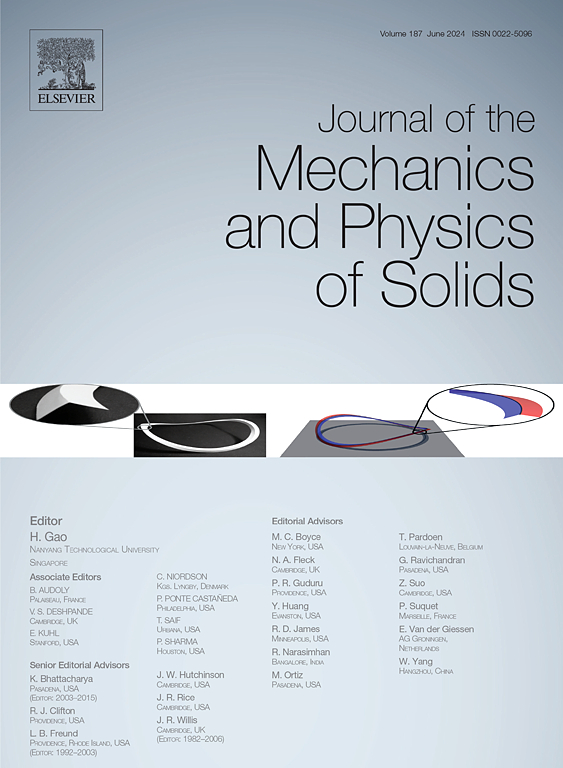多相薄膜代表性体积元的弹性问题
IF 5
2区 工程技术
Q2 MATERIALS SCIENCE, MULTIDISCIPLINARY
引用次数: 0
摘要
多相薄膜由于其尺寸和相间的相互作用而表现出独特的物理功能。在这些材料中,弹性在其生长和物理性能中都起着重要的作用。在这方面的一个突出问题是薄膜系统的代表性体积元(RVE)的弹性公式。由于薄膜RVE在垂直于薄膜自由表面的方向上缺乏平移不变性,因此RVE的边值问题涉及到必须与控制弹性边值问题一起满足的积分运动学边界约束。这些约束在这里被开发为均匀化方案的一部分,设计用于在相内具有特征应变和模量不匹配的非均质薄膜中提供弹性溶液。提出了一种基于快速傅立叶变换和增广拉格朗日不动点迭代算法的迭代求解方案。数值解以著名的均匀和非均匀圆柱形夹杂的Eshelby问题的解析解为基准。用扩散界面和离散格林算子方法研究了界面处吉布斯振荡的衰减。利用动力学蒙特卡罗模拟在不同生长条件下生成的薄膜形貌示例作为微观结构输入来测试当前方法。结果表明,弹性能倾向于集中在柱/基体界面附近。这种方法有望实现弹性溶液与薄膜生长模型的动态耦合,以解释弹性应变对扩散、键合和界面能的影响。本文章由计算机程序翻译,如有差异,请以英文原文为准。
On the elastic problem of representative volume element for multiphase thin films
Multiphase thin films exhibit unique physical functionalities stemming from their dimensions and interactions among phases. In these materials, elasticity plays an important role both in their growth and physical performance. An outstanding problem in this regard is the elastic formulation of representative volume element (RVE) of thin film systems. As thin films RVEs lack translation invariance in the direction perpendicular to the film free surface, the boundary value problem of the RVE involves integral kinematic boundary constraints that must be satisfied together with the governing elastic boundary value problem. These constraints were developed here as a part of a homogenization scheme designed to deliver the elastic solution in a heterogeneous thin film, with both eigenstrain and modulus mismatch within the phases. We formulated this problem together with an iterative solution scheme based on Fast Fourier Transform with an augmented Lagrangian fixed-point iteration algorithm. The numerical solution was benchmarked with the analytical solution of the famous Eshelby problem for the case of homogeneous and inhomogeneous cylindrical inclusions. Diffuse interface and discrete Green's operator methods were tested to investigate the attenuation of Gibbs oscillations at interfaces. Examples of thin film morphologies generated using kinetic Monte Carlo simulations at different growth conditions were used as microstructure input to test the current approach. We show that the elastic energy tends to be concentrated near the pillar/matrix interface. This approach is expected to enable the on-the-fly coupling of elasticity solution with thin film growth models to account for the elastic strain effects on diffusion, bonding, and interfacial energies.
求助全文
通过发布文献求助,成功后即可免费获取论文全文。
去求助
来源期刊
CiteScore
9.80
自引率
9.40%
发文量
276
审稿时长
52 days
期刊介绍:
The aim of Journal of The Mechanics and Physics of Solids is to publish research of the highest quality and of lasting significance on the mechanics of solids. The scope is broad, from fundamental concepts in mechanics to the analysis of novel phenomena and applications. Solids are interpreted broadly to include both hard and soft materials as well as natural and synthetic structures. The approach can be theoretical, experimental or computational.This research activity sits within engineering science and the allied areas of applied mathematics, materials science, bio-mechanics, applied physics, and geophysics.
The Journal was founded in 1952 by Rodney Hill, who was its Editor-in-Chief until 1968. The topics of interest to the Journal evolve with developments in the subject but its basic ethos remains the same: to publish research of the highest quality relating to the mechanics of solids. Thus, emphasis is placed on the development of fundamental concepts of mechanics and novel applications of these concepts based on theoretical, experimental or computational approaches, drawing upon the various branches of engineering science and the allied areas within applied mathematics, materials science, structural engineering, applied physics, and geophysics.
The main purpose of the Journal is to foster scientific understanding of the processes of deformation and mechanical failure of all solid materials, both technological and natural, and the connections between these processes and their underlying physical mechanisms. In this sense, the content of the Journal should reflect the current state of the discipline in analysis, experimental observation, and numerical simulation. In the interest of achieving this goal, authors are encouraged to consider the significance of their contributions for the field of mechanics and the implications of their results, in addition to describing the details of their work.

 求助内容:
求助内容: 应助结果提醒方式:
应助结果提醒方式:


